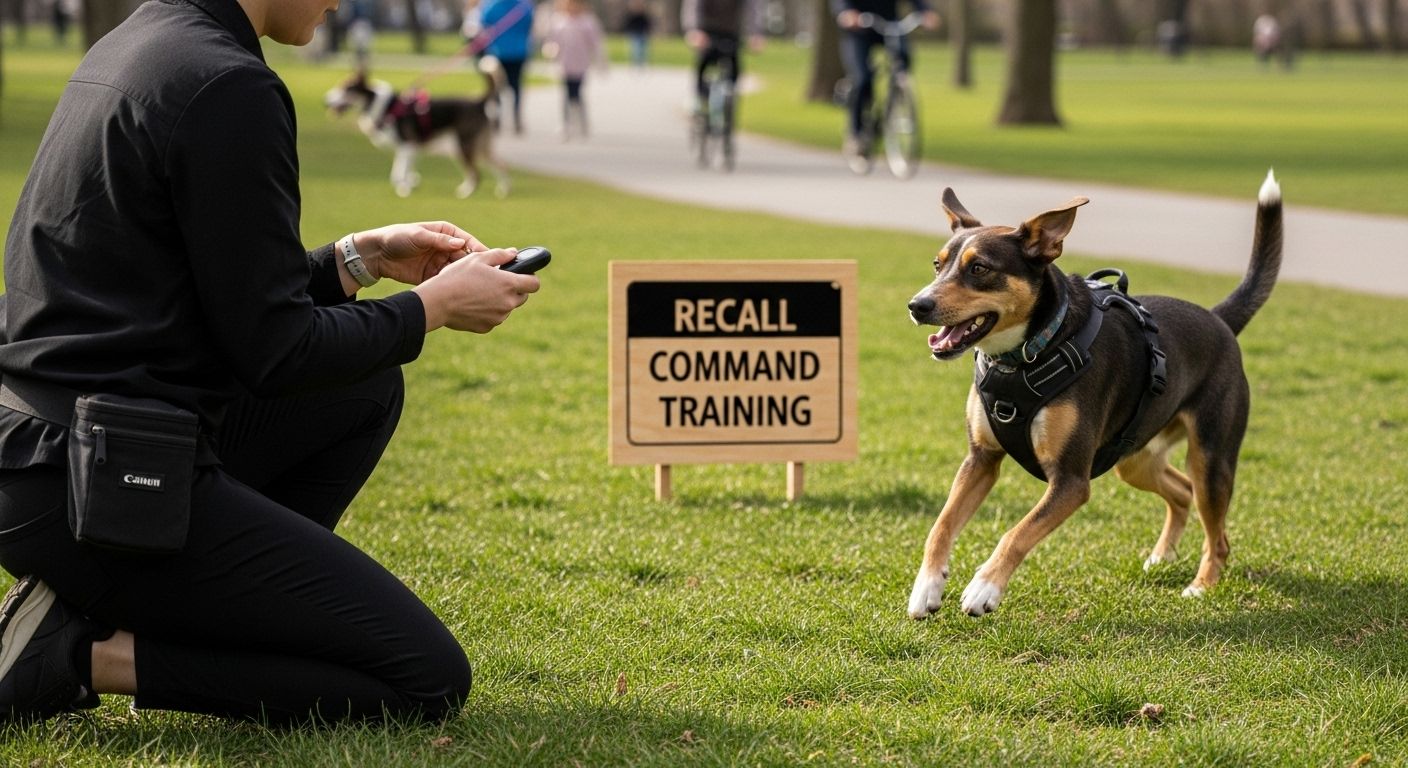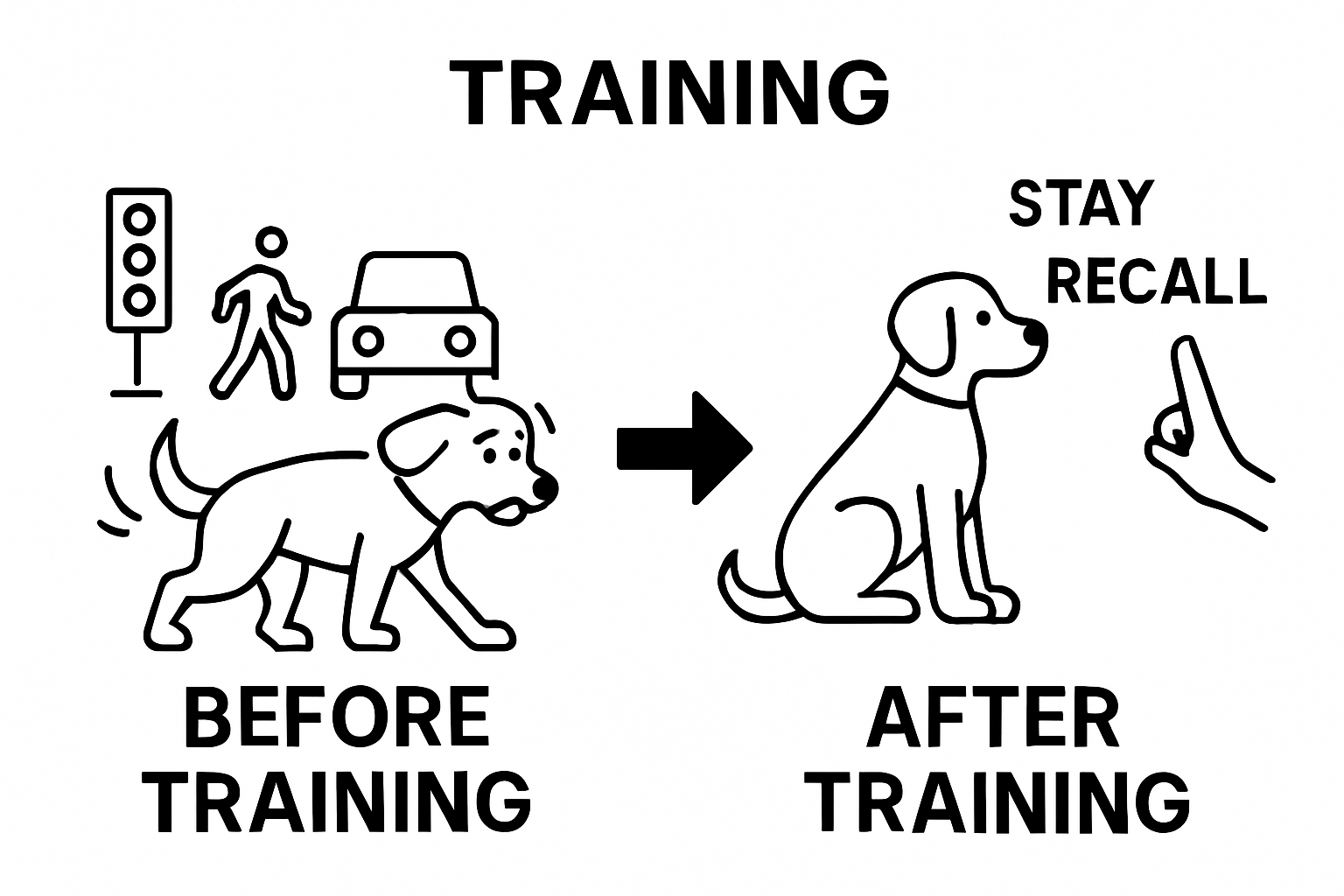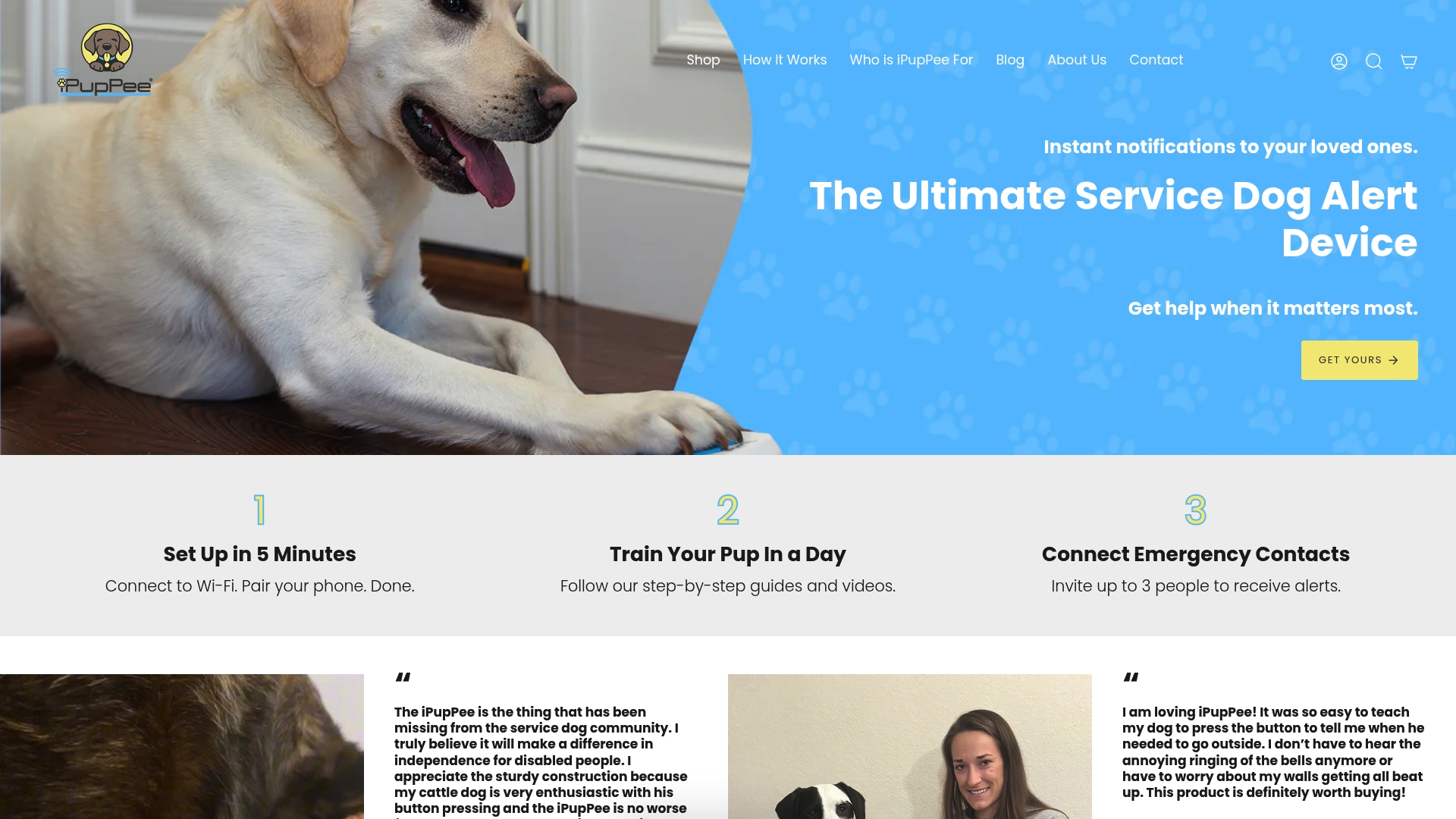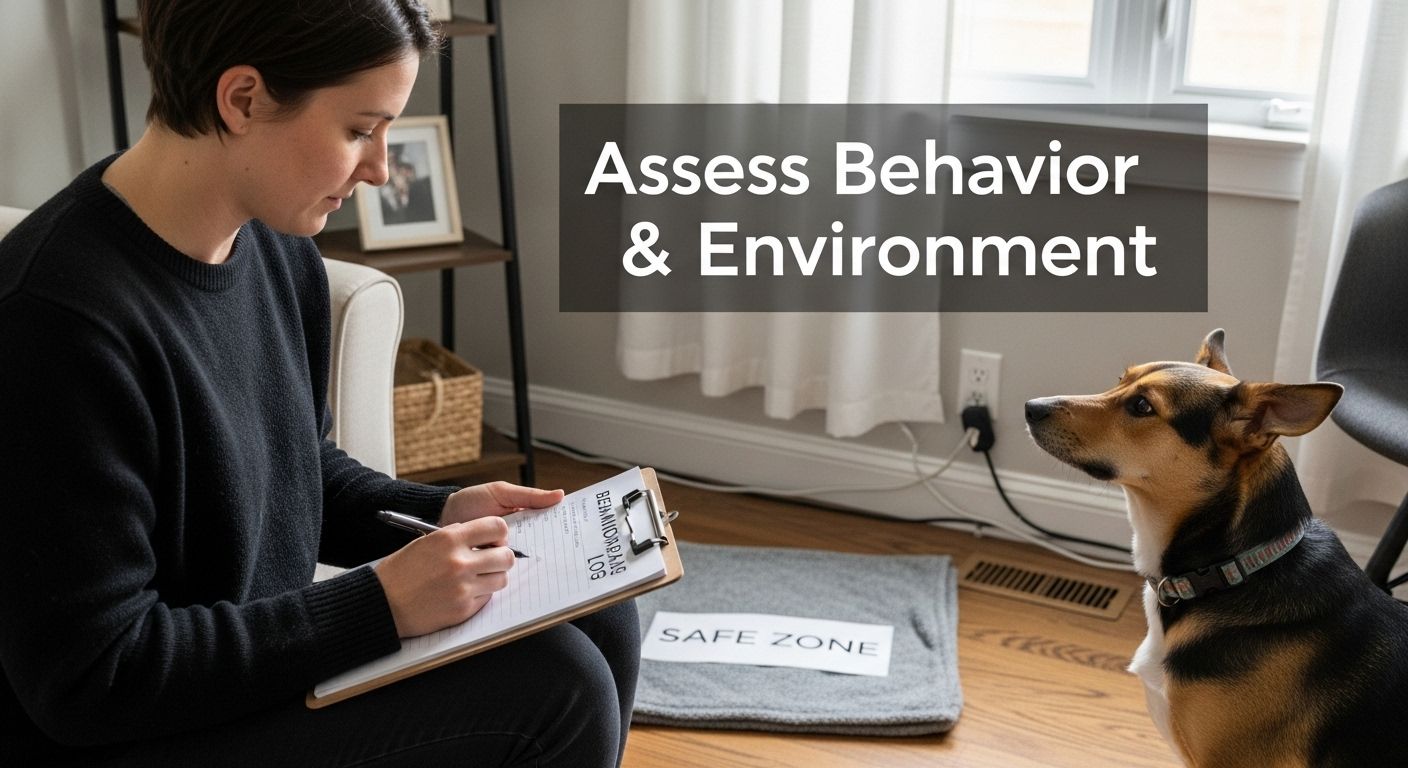Training your dog for safety goes far beyond teaching fun tricks and simple obedience. Most pet owners miss the real risks hiding in everyday spaces, yet aggressive or anxious behaviors like growling or stiffening signal urgent issues that need attention. What if the key to true safety is not the commands themselves, but how well you understand your dog’s instincts and surroundings right from the start?
Table of Contents
- Step 1: Assess Your Dog’s Current Behavior And Environment
- Step 2: Gather Essential Training Tools And Resources
- Step 3: Implement Basic Commands For Safety Awareness
- Step 4: Conduct Real-Life Safety Situations Practice
- Step 5: Evaluate Progress And Adjust Training Techniques
- Step 6: Reinforce Training Consistently For Lasting Habits
Quick Summary
| Key Point | Explanation |
|---|---|
| 1. Assess your dog’s behavior and environment | Understand your dog’s actions and surroundings to identify risks and triggers for effective training. |
| 2. Gather essential training tools | Assemble high-quality resources like a comfortable harness and positive reinforcement tools to enhance training effectiveness. |
| 3. Implement basic safety commands | Teach fundamental commands like ‘come’, ‘stay’, and ‘wait’ to establish safety communication between you and your dog. |
| 4. Practice real-life safety situations | Gradually expose your dog to challenging environments to reinforce learned safety commands and promote reliable responses. |
| 5. Evaluate progress and adjust techniques | Monitor your dog’s development and adapt training methods to ensure they meet individual learning needs and progress effectively. |
Step 1: Assess Your Dog’s Current Behavior and Environment
Successful training for dog safety begins with a comprehensive understanding of your canine companion’s current behavioral baseline and living environment. This initial assessment provides critical insights that will shape your entire training strategy, helping you identify potential risks, triggers, and areas requiring focused intervention.
The first step involves creating a detailed behavioral profile by observing your dog’s interactions, reactions, and communication patterns. Watch how your dog responds to different stimuli like strangers, other animals, loud noises, and sudden movements. Pay close attention to body language signals such as ear positioning, tail movement, and overall posture. Aggressive or anxious behaviors like growling, excessive barking, or sudden stiffening are red flags that demand immediate understanding.
Environmental assessment is equally crucial in training dogs for safety. Examine your home and outdoor spaces from your dog’s perspective, identifying potential hazards or stressors. Look for areas that might trigger anxiety or defensive responses. This might include narrow hallways where your dog feels cornered, spaces with unpredictable loud sounds, or zones with limited escape routes. Learn more about creating safe spaces for your canine companion.
To document your observations effectively, consider creating a behavioral log. Record specific incidents, noting the context, your dog’s reactions, and any apparent triggers. This documentation will become an invaluable resource throughout your safety training journey, allowing you to track progress and recognize patterns.
According to the CDC, understanding your dog’s behavior is crucial for preventing potential incidents. By investing time in this initial assessment, you lay a strong foundation for targeted, compassionate training that enhances both safety and your dog’s overall well-being.
Step 2: Gather Essential Training Tools and Resources
Building a comprehensive safety training toolkit requires strategic selection of resources that support positive, effective learning for both you and your dog. This step focuses on assembling the right equipment and materials that will facilitate smooth, productive training sessions while ensuring your dog’s comfort and motivation.
High-quality training tools are your foundation for successful safety instruction. Start by selecting a well-fitted, comfortable harness that provides control without restricting movement. Avoid choke or prong collars, which can create negative associations and potentially harm your dog. Instead, opt for a front-clip harness that helps manage pulling and provides gentle guidance during training exercises. Explore comprehensive training resources to enhance your approach.
Your training toolkit should include an assortment of reward-based tools that motivate and engage your dog. Collect various high-value treats in different sizes and textures—soft, chewy treats work best for quick rewards during training. A treat pouch that attaches to your waist keeps rewards accessible and maintains training momentum. Additionally, invest in a clicker for precise marker training, which helps communicate exactly when your dog performs the desired behavior.
According to the American Veterinary Society of Animal Behavior, reward-based training methods are most effective for long-term behavior modification. Essential safety training resources extend beyond physical tools and include educational materials like training guides, instructional videos, and potentially professional consultation. Consider creating a dedicated training notebook to track progress, document challenges, and record successful strategies.
Verify your toolkit’s completeness by ensuring you have a range of treats, a comfortable harness, a clicker, a treat pouch, and educational resources. Your preparation sets the stage for structured, positive safety training that builds trust and understanding between you and your canine companion.
Below is a summary table of essential tools and resources mentioned in the article, along with their purposes to help organize your safety training preparation.
| Tool/Resource | Purpose | Notes |
|---|---|---|
| Comfortable harness | Provides control and safety without discomfort | Choose front-clip; avoid choke/prong |
| High-value treats | Motivates and rewards correct behavior | Use soft, chewy treats for quick reward |
| Treat pouch | Keeps rewards accessible during training sessions | Attaches to waist for convenience |
| Clicker | Precise marker for training timing | Aids in clear communication |
| Training notebook | Documents progress, incidents, and adjustments | Track successes and challenges |
| Educational materials | Guides, videos, and professional insights | Supplements hands-on training |
Step 3: Implement Basic Commands for Safety Awareness
Basic safety commands form the critical communication foundation between you and your dog, creating a language that can prevent dangerous situations and potentially save lives. These core commands transform your relationship from simple companionship to a structured partnership focused on mutual protection and understanding.

The recall command emerges as the most critical safety skill, teaching your dog to return immediately when called, regardless of distractions. Begin training in a quiet, controlled environment with minimal interruptions. Use a consistent, clear verbal cue like “come” or your dog’s name, paired with an enthusiastic, positive tone. Start by practicing in short distances, rewarding your dog with high-value treats and genuine excitement when they respond correctly. Discover advanced safety training techniques to reinforce these crucial skills.
Establishing reliable ‘stay’ and ‘wait’ commands provides additional layers of safety protection. These commands differ subtly but critically—‘stay’ means holding a specific position until released, while ‘wait’ suggests pausing momentarily. Practice these commands in progressively more challenging environments, introducing distractions gradually. For instance, ask your dog to stay while you move a few steps away, incrementally increasing distance and duration. Always use a consistent release word like ‘okay’ to signal when they can move.
According to UC Davis School of Veterinary Medicine, no recall training is 100% foolproof, so maintaining physical control through leashes and secure environments remains essential. To verify command mastery, test your dog’s response in increasingly complex scenarios: near street crossings, with other dogs present, or amid mild distractions.
Successful implementation means your dog consistently responds within three seconds, demonstrating not just obedience, but a developed understanding of safety-focused communication.
Step 4: Conduct Real-Life Safety Situations Practice
Transitioning from controlled training environments to real-world scenarios is crucial for developing genuine safety awareness and reliable response skills. This step focuses on deliberately introducing your dog to complex, unpredictable situations that test and reinforce the commands and behaviors learned in previous training stages.
Systematic exposure to varied environments builds true safety competence. Begin by selecting progressively challenging locations that simulate potential real-life encounters—busy sidewalks, parks with other dogs, areas with unexpected noises, or spaces with multiple distractions. Start at a distance that keeps your dog comfortable and gradually decrease proximity as their confidence grows. Explore advanced safety training strategies to enhance your approach.
Practice involves creating controlled simulations that challenge your dog’s learned safety commands. This might include staging scenarios like sudden loud noises, encountering strangers, or navigating crowded spaces while maintaining focus on your instructions. Use a long training lead for added security, allowing your dog some movement while ensuring you can quickly regain control if needed. Reward calm, focused behavior immediately to reinforce the desired response. Pay special attention to your dog’s body language, watching for signs of stress or overstimulation that might require backing off and adjusting the training intensity.
According to FEMA’s canine training guidelines, successful safety training requires dogs to perform consistently across diverse and challenging environments. Verification of mastery includes your dog’s ability to maintain focus, respond to commands within three seconds, and demonstrate calm behavior when encountering unexpected stimuli. Document your training sessions, noting improvements and areas requiring additional practice, to create a comprehensive safety training record that tracks your dog’s progress and identifies ongoing development opportunities.
Step 5: Evaluate Progress and Adjust Training Techniques
Evaluating your dog’s safety training progress requires a systematic, compassionate approach that recognizes individual learning patterns and potential challenges. This step transforms your training journey from a rigid program to a dynamic, responsive process that adapts to your dog’s unique needs and developmental trajectory.
Consistent documentation becomes your most powerful training tool. Create a detailed log tracking command performance, behavioral changes, and specific scenarios where your dog demonstrates increased safety awareness. Video recordings provide an objective perspective, allowing you to review interactions you might miss in real-time. Explore advanced tracking techniques to enhance your monitoring approach.
Develop a structured assessment framework that goes beyond simple command compliance. Evaluate your dog’s overall confidence, stress levels, and ability to maintain focus during increasingly complex situations. Pay attention to subtle behavioral shifts—increased calmness around previous triggers, more reliable recall in distracting environments, or improved body language during potential stress scenarios. These nuanced indicators often reveal more about training effectiveness than strict command performance.
According to the American Animal Hospital Association, successful training requires ongoing collaborative assessment. Be prepared to modify your approach if progress stalls or if your dog shows signs of frustration. This might mean breaking complex commands into smaller steps, adjusting reward strategies, or temporarily reducing training intensity. Verification of successful evaluation includes your ability to objectively document progress, identify specific areas needing improvement, and implement targeted adjustments that maintain your dog’s motivation and confidence throughout the safety training process.
Step 6: Reinforce Training Consistently for Lasting Habits
Consistent reinforcement transforms initial training into permanent safety behaviors, creating an automatic response system that protects your dog in potentially dangerous situations. This final step focuses on embedding learned commands so deeply that they become second nature, transcending structured training sessions and integrating seamlessly into daily life.
Frequency and timing of reinforcement matter more than occasional intensive training. Integrate safety commands into everyday interactions, practicing brief, spontaneous training moments throughout the day. This might mean randomly requesting a ‘stay’ command before opening a door, or practicing recall in different household rooms with varying levels of distraction. Discover advanced consistency techniques to enhance your approach and maintain your dog’s engagement.
Develop a variable reward system that keeps your dog motivated and attentive. While treats remain a powerful initial motivator, gradually transition to intermittent reinforcement using a mix of food rewards, verbal praise, physical affection, and play. This approach prevents reward dependency and maintains the dog’s intrinsic motivation to perform safety commands. Pay attention to your dog’s individual preferences—some dogs respond more enthusiastically to a favorite toy or specific type of praise than to food rewards.
According to the Cummings School of Veterinary Medicine at Tufts University, successful long-term training requires practicing commands in progressively more challenging environments. Verification of mastery includes your dog’s ability to perform safety commands consistently across different scenarios, with reduced reliance on high-value treats and increased responsiveness to verbal and physical cues. The ultimate goal is creating an intuitive safety partnership where your dog understands and anticipates potential risks, responding reliably even in unexpected situations.
Refer to this checklist table to verify that your dog consistently meets the key completion criteria for each safety training step before moving forward.
| Step | Verification Criteria | How to Check |
|---|---|---|
| Behavior Assessment | Behavioral log includes specific triggers and responses | Review and update log regularly |
| Tools Preparedness | All key tools are assembled and in working order | Cross-check toolkit before sessions |
| Command Implementation | Dog responds to basic commands within three seconds | Practice with mild distractions |
| Real-Life Practice | Dog maintains focus and calm in complex scenarios | Simulate new environments and document results |
| Progress Evaluation | Adjustments documented based on observed challenges and successes | Use video and written records |
| Consistent Reinforcement | Commands performed reliably with variable rewards in daily life | Test across settings with different motivators |

Bring Real Safety to Life With Proven Solutions From iPupPee
You want your dog to be truly safe, not just obedient in quiet moments. This article showed how understanding behavior, building positive habits, and practicing safety commands are crucial for every dog and owner. But unpredictable situations and real emergencies can expose training gaps, especially when you need fast, clear communication. For people living alone or with special needs, reliable alerts and direct interaction can make all the difference. Imagine your dog being able to notify you or someone else of trouble by simply pressing a button. That kind of connection turns training into real security.

Ready to turn knowledge into action? The iPupPee alert device was designed for dog owners who take safety seriously. Explore our unique technology that bridges communication between you and your dog so your training pays off in any situation. You can also learn more about how this device supports independence and protection for households of all types. Visit iPupPee now and make your home a model for safety and peace of mind. Take your next step today before another uncertain moment arrives.
Frequently Asked Questions
What are the first steps to assess my dog’s behavior for safety training?
Successful safety training begins with a comprehensive understanding of your dog’s current behavior and environment. Observe their interactions with various stimuli, document body language, and identify potential triggers to create a detailed behavioral profile.
What essential tools do I need for training my dog for safety?
Key training tools include a comfortable, well-fitted harness, high-value treats for rewards, a clicker for precise marking, and educational materials like training guides. These items help facilitate a positive and productive training experience.
How do I teach my dog important safety commands?
Start with basic commands such as ‘come,’ ‘stay,’ and ‘wait.’ Use clear verbal cues and practice in a controlled environment, gradually increasing distractions. Reward your dog immediately for correct responses to reinforce the behavior.
How can I ensure lasting safety behaviors in my dog?
Consistent reinforcement is crucial for lasting safety behaviors. Integrate commands into everyday interactions and use a variable reward system, gradually transitioning from constant treats to praise and play to keep your dog motivated.

